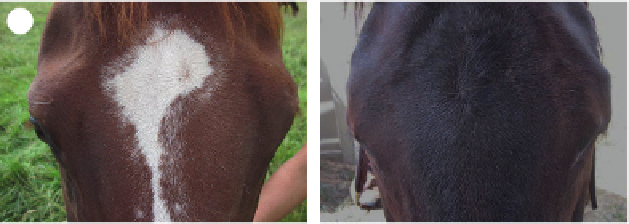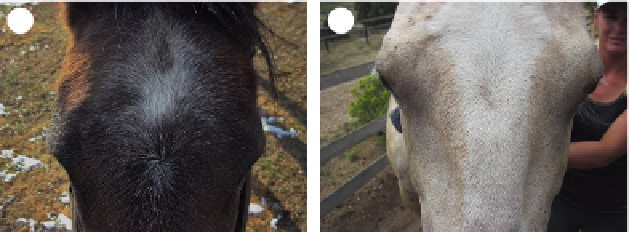Biology Reference
In-Depth Information
involved two groups of young Konik horses reared under conventional
stable conditions (24 horses), or in a forest reserve under semi-natural condi-
tions (31 horses). The horses were grouped into four classifications based on
their hair whorl position and/or shape: a single whorl high above the top of
the eye line; a single whorl between the top and the bottom of the eye line; a
single whorl below the bottom of the eye line; and four horses had an elon-
gated or double whorl (
Figure 7.4
). All of the horses were tested only once
in three behavioral tests: being led away by a familiar handler (first moving
away from the stable, then toward the stable); leg lifting; and a novel object
test. In the novel object test, a familiar handler restrained each horse while
another familiar handler approached and suddenly opened an umbrella from
a distance of 5
6 m. Heart rate was monitored telemetrically during testing.
The results revealed that horses with a high hair whorl were significantly
more difficult to handle than horses with a medium or low hair whorl, but no
significant differences were observed in cardiac reactivity. Horses with an
elongated or double hair whorl were the most cautious of the groups when
approaching a strange object. They took much longer than the single-
whorled horses to approach and touch something new. The lack of a correla-
tion between heart-rate measurements, startle responses, and hair whorl
height in this study may be explained by the fact that Konik horses are
known for a calm and gentle temperament (
PetMd, 2012
). This is similar to
the lack of correlation between hair whorl height and temperament
in
(a)
(b)
(c)
(d)
FIGURE 7.4
Classification of hairwhorl positions on the forehead of the horse. (a) High right,
(b) High left, (c) Middle, (d) Low.







Search WWH ::

Custom Search